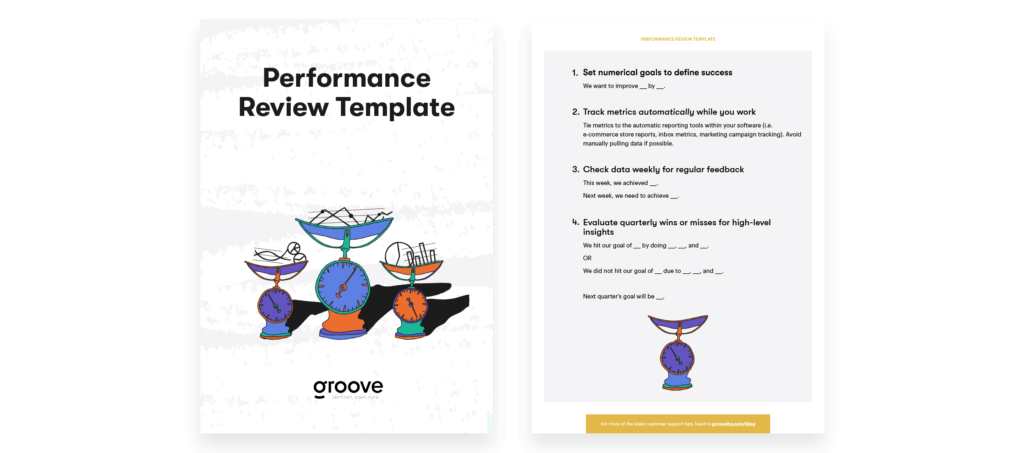Traditional performance reviews weren’t working for us. So we got rid of them. Here’s what we do instead that saves us over 40 hours each quarter.
In the past, my performance reviews all went exactly the same.
You’re doing great! You need to speak up more. Everyone likes you!
Okay, great, thanks. Can I go back to work now?
When I stepped up to team lead, the process somehow got worse. I spent weeks writing reviews of my colleagues, gathering evidence of success or failure for team members, and sitting in hour-long meetings delivering all this nonsense.
From both sides of the table, I found performance reviews to be a complete waste of time.
Groove does it differently. I don’t pause my workflow to compile data or write lengthy reviews anymore. The ultimate judgment comes from automatically-tracked metrics. Not from ourselves, our colleagues, or our managers.
Here’s the process we’ve developed and why it works.
Our “performance review” template
I use the words “performance review” very loosely since we got rid of traditional reviews entirely. But since we’re all familiar with the phrase, I’ll use it to drive home how you can replace your current idea of “performance reviews” with a less formal process by setting data-driven expectations and assigning accountability.
Employee performance reviews typically cover these two things:
- Your ability to hit personal, team, and company goals
- Your affect on company culture
Our “performance review” template covers the former. The latter is something we address on the spot, as soon as issues come to light.
We’ll touch briefly on how we deal with cultural issues at the end of the article. But for the most part, this post will cover how we eliminated the bulky performance review process and are better for it.

1. Set numerical goals to define success
We decide on goals at the start of each review period. In certain circumstances, we set goals before hiring a new team member. (For instance, if average reply time increases, we’ll hire a new support agent specifically to improve that metric.)
Every goal is tied to a number and owned by a team or individual.
For example, here’s a look at the marketing team’s goal for weekly blog visitors. Right now, we’re around 16,000 weekly visitors and the goal is to get to 20,000. Simple as that.


Especially as a small business, this encourages each employee to take ownership of their work and to correlate their goal to the success of the entire company.
There’s no need to set up a formal performance review. Every employee has access to this data and holds themselves accountable to hit it.
2. Track metrics automatically while you work
I look back sorely on the many days spent gathering evidence to prove I was doing my job for a performance review while neglecting to do my job.
I combed through old Trello cards and email campaigns to present my performance highlights. The first time my manager saw them was at this review meeting. Heck, the first time I saw my performance metrics were at this quarterly meeting.
We automate this entire process at Groove. By simply using software that does it for us.


We make sure each of our tools contains a reporting dashboard that updates in real-time. To view progress on our goals, we select dates from a drop-down menu. It takes 5 seconds.

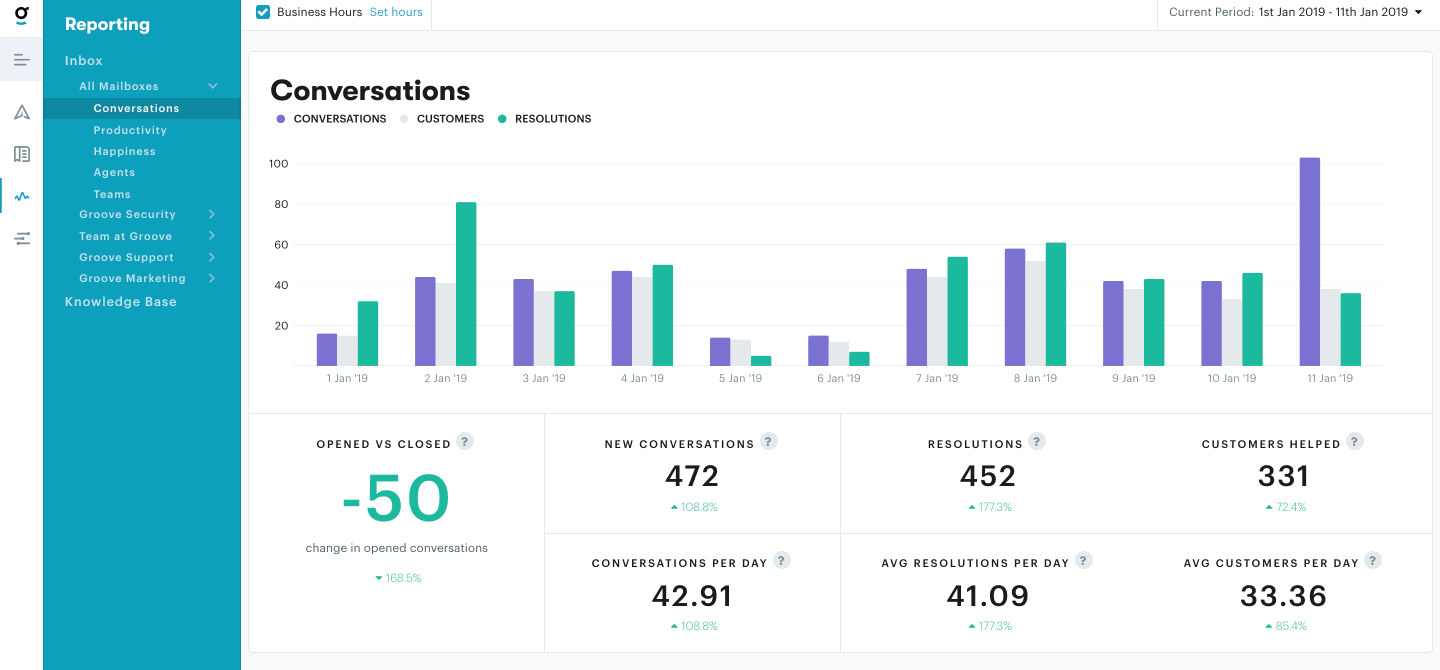
Computers track all our metrics in the background while we work. With all the SaaS tools available, there’s no reason to spend time gathering all this data yourself.
3. Check data weekly for regular feedback
After streamlining our goal process, checking on it became second nature. The metrics live on the platforms we use daily and update in real-time.
Some team members schedule a weekly calendar event to view their own stats. Other teams set up recurring team or 1-1 meetings to track them together. The key is to incorporate these check-ins into your workflow.

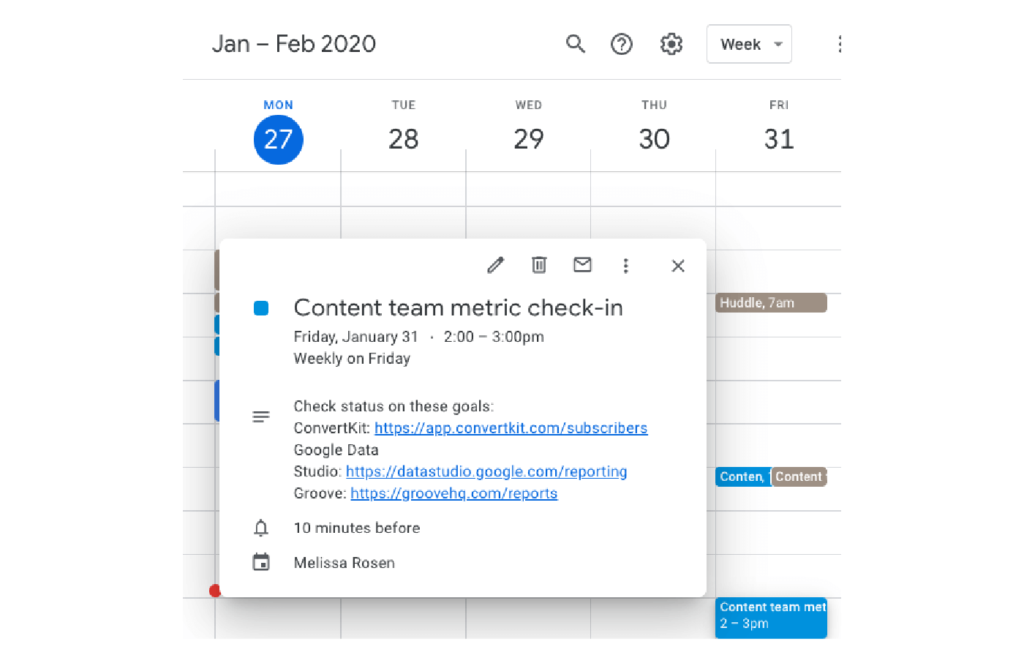
Our Chief Product Officer is an agile junkie and has forced us helped align all our internal teams on an agile framework. While there are many agile methodologies, here at Groove we’ve mainly adopted Scrum.
Scrum asks teams to commit to a specified backlog of work over a set period, known as sprints (our sprints last two weeks here at Groove). At the end of each sprint, we have a “Ceremony” (Scrum term for meeting) where we review our completed work and check in on our goals.
These aren’t weirdly formal performance review meetings where someone’s job destiny hangs in the air. Rather, it’s a way to provide leadership with updates, get feedback, and stay on track with our deadlines.
A biweekly cadence allows us to change course if needed. We give new strategies two weeks to prove themselves. If the metrics go in the wrong direction, we adjust.
4. Evaluate quarterly wins or misses for high-level insights
We use quarterly overviews to see how our ability to hit goals trends over time. Unlike weeklies, quarterlies provide enough data to draw conclusions and anticipate future trends.


We set up one-on-one, team-specific, and company-wide meetings to look at the results together. Our numerical goals determine success.
Our team celebrates wins and uses the momentum to create new goals for the next quarter.
Losses evoke questioning into why it didn’t work:
- Is this goal realistic?
- Do we have control over this metric?
- What prevented our team from success?
There’s no cumbersome evaluation system as with traditional performance reviews. No other people involved. No employees’ feelings are hurt. No forms to fill out to evaluate co-workers. Numbers place the judgment, we just interpret the results.
“Performance review” example: Our support team’s CSAT goal
To drive the point home, let’s walk through our customer support team’s goals and our “non-performance review” process.
1. We set a CSAT goal of 85%
On January 1, we set a goal to hit 85% CSAT by April 1.
In the previous quarter, we hovered around 80-82%. So this seems realistic.
The head of our support team sets the goal, our founder approves it, and the rest of the team agrees on it. We determine if it’s achievable, in line with our core values, and will add value to our customers.
2. We automatically track CSAT using Groove
We’re all familiar with the CSAT report in our shared inbox. Now, we focus on exactly what is tracked, how it’s tracked, and what affects the data.
Here’s what we see:

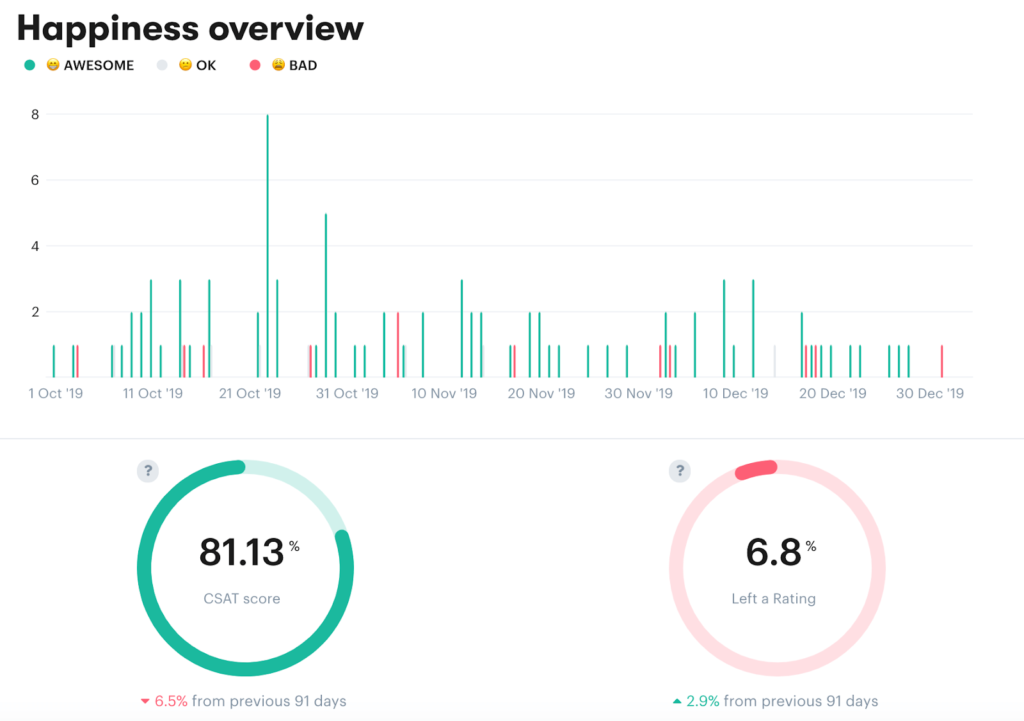
Our current score sits on the bottom left corner. This is the number we want to rise to 85% within the next 3 months.
The right corner offers an interesting insight. We decide to make this a sub-goal of the larger one. If we can improve the percent of people who leave a rating, we hypothesize ratings will improve too.
Our head of support assigns this particular metric to another support team member. They will be responsible for coming up with and executing on projects to get more ratings.
The chart at the top gives us a way to see trends over time and correlate CSAT with certain dates. Another team member will investigate the highest and lowest scores over the past quarter and recommend tactics for the future.
While they work on individual projects, the inbox tracks CSAT progress automatically.
3. We meet weekly for CSAT updates
Each week, our manager holds both 1-1s and team meetings to look at the CSAT report together in Groove. We select the past week as date parameters and dissect the metrics from each day.

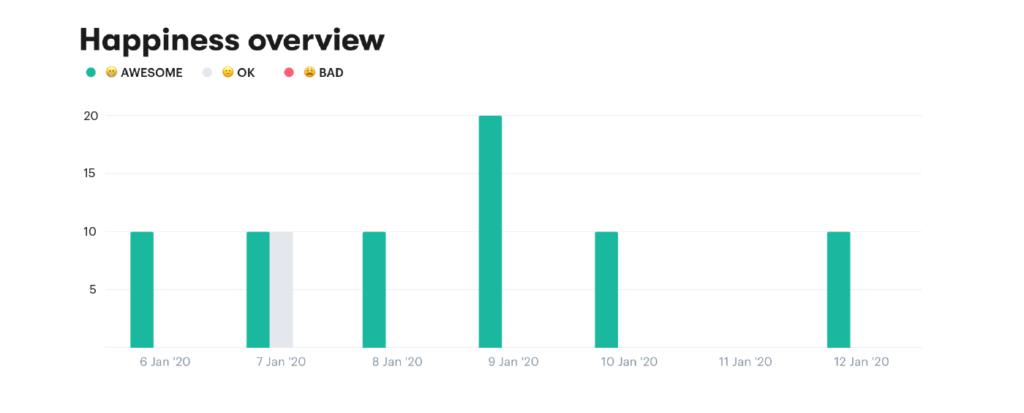
We discuss how each of our projects is contributing to the overall score, brainstorm more ideas, and change course if needed.
We’re getting good reviews so far, but the volume hasn’t increased much. We’ll rev up our effort on that project.
4. We discuss quarterly goal success or failure with the entire company
At the end of the quarter, we hold a larger meeting with everyone in the company to discuss our CSAT goal.
If we hit 85% CSAT…
We consider it a win and tie this success to other wins throughout the company, like an increase in retention or revenue.
Then, we’ll set a higher CSAT goal for the next quarter. Depending on how easily we hit the goal, the next goal will either be more ambitious (like 90% CSAT) or focus on steady improvement (remain at 85% or inch up to 87%).
If we fell short of 85% CSAT…
We share our learnings with the entire team. Drawing conclusions from the past three months of data, we’ll determine why this didn’t work.
We’ll correlate related metrics to see how product issues, inbox coverage, or marketing strategies may have affected our success.
Once we figure out the why through data analysis, we can move in the right direction and set goals for the future.
Cultural feedback: The only time it’s okay to use awkward performance review phrases
Now, I said we’d get back to the “cultural” aspect of the traditional review process. Most companies wait to address culture fit issues at these performance review meetings. Which means that a bad egg stinks up the office for weeks or months until this meeting takes place.
There’s no time for that in the startup world.
When it comes to cultural feedback, we address it as soon as possible. This involves more emotional feedback related to cultural fit, employee engagement, manager and employee relationships, and long-term growth and development concerns.
In other words, the awkward stuff.
There’s a lot of fill-in-the-blank phrases and advice on the internet about how to deliver feedback. It all feels weird to use when talking to co-workers you presumably talk to every day.
But some of these phrases get it right.
And truthfully, most of us do need a little help to make sure we’re delivering feedback effectively.
Here’s a collection of phrases that have worked for us:


Setting up your own “performance review” process
Like everything here at Groove, we went through tons of trial and error before we got this process right. And it will always be a work in progress.
I’ve seen so many startups waste valuable time on bulky performance review plans. The saddest part is that their intentions are so good!
You want to improve. You want employees to succeed. You want to quantify wins.
Your process just needs a revamp. Take our template and try it within your own organization:


